The Museum Collections
Introduction
I. History and Art Collection
1. Icons of the 14th – 19th centuries
icons of the 14th – 17th century
2. Jewelry art of the 14th – 20th century
jewelry art of the 14th – 17th century
jewelry art of the 18th – 19th century
the european silver 14th - 19th centuries
3. Small-size sculptures (works of metal, wood, bone)
XI – the beginning of the XX century
Small-size sculptures 11th – 17th century
Small-size sculptures 18th – early 20th century
enamel of Troitza masters 15-8th – early 20th century
5.Embroidery, lace, textiles of the 14th - early 20th century
icon and ornamental embroidery
gold and silver lace
6.Painting of the 18th – 21st centuries
painting of the 18th – 19th centuris
painting of the 20th – 21st centuris
II.Manuscripts and old printed books of the 14th – 17th century
IV.Lithography of the 18th – 19th century
V.Numismatics
VI.Medals of the 18th - early 20th century
VIII.Archeology collection
IX. Russian folk and applied and decorative art of the 17th – 21st c.
1. Artistic wood
folk carved and painted wood
wooden toys
house carving of Sergiev Posad
Khokhloma and Gorodets painting
2. Artistic textiles
embroidery and weaving
printed textiles and lace
Russian shawls
folk costumes
folk garments
printed cotton kerchiefs
|
European silver 14th- 19th centuries (page 2)
English silver of the 16th-17th centuries
|
|
The Museum includes a small, but interesting collection of the 16th – 17th century English silver that is considered the best in the world. English silver articles came to Russia as ambassadorial and diplomatic
presents. The works of English silversmiths of the Tudors and Stuarts period were preserved not only in the royal treasury. As gifts and contributions, English goblets, mugs, plates, jugs were also included in the monastery sacristies.
In England Renaissance spread in applied art later then in Continental Europe. English silversmiths were noticeably influenced by the craftsmen of Germany and Netherlands. The works of British Renaissance craftsmen are distinguished by the logical and symmetrical structure, clear shape, emphasized functional parts. English silver of that time looks rather simple and bourgeois. The plain shapes and even contours correspond to the British solidity and reserved decorativeness.
The goblet 0f 1584 – 1585 made by Semeone Brooke is a characteristic work of English Renaissance silver. The “pumpkin” shape is borrowed from German craftsmen. The goblet is decorated with a thing engraved pattern. The other goblet with a deep, egg-shaped bowl, solid foot and characteristic bell-shaped bottom is typically insular. The Museum collection also comprises the wash-hand set. The jug is a high elegant vessel shaped like a vase. The upper part of the jug is decorated with a stripe of a chased ornament of oval medallions depicting sea monsters. The decoration of the matching dish-basin is austere and modest.
|

Goblet. 1584-1585. Master Semeone Brooke |
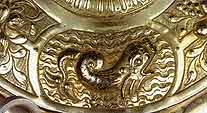
Wash-hand set: 1. Dish-Basin. 1597-1598.2. Water Jug. 1612-1613. |

Water jug. 1612-1613. Detail |

Goblet. 1605-1606. Craftsman F. Terry
|
|
There is another similar dish. Its surface is thickly covered with a chased and engraved pattern. The bottom id decorated with chasing in high relief: there are hunting scenes around the raised central part, tritons against the sea waves in medallions along the external ring and winged “snake-legged” sea-cows. The wide edge is decorated with a thick wavy ornament with chased dolphins, fish, snails and shells. No wonder that such a sea power like England had a lot of decorative elements in applied art.
|
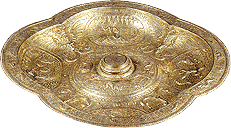
Dish-basin. 1613-1614. Master monogram «ÀÒ» |
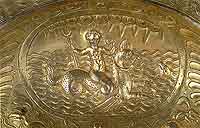
Dish-basin. 1613-1614. Master monogram «ÀÒ». Detail of engraving |
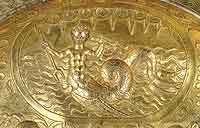
Dish-basin. 1613-1614. Master monogram «ÀÒ». Detail of engraving |
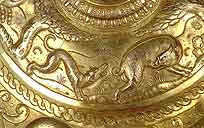
Dish-basin. 1613-1614. Master monogram «ÀÒ». Detail of engraving |
|
The mug of 1670 with master’s monogram “AL” and large engraved ornament is referred to baroque style. Its floral decoration reflects a leading trend in English and European silver in the mid-17th century. The mug’s body is adorned with three large roundels . The central roundel depicts a double emblem. Architectural landscapes are engraved on the sides. The lower part is decorated with a floral pattern.
|
|
|

Mug. 1670. Master monogram «AL» |
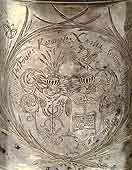
Mug. 1670. Master monogram «AL». Detail. |
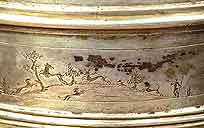
Mug. 1670. Master monogram «AL». Detail. |
|
All these items are magnificent works of English silversmiths. They give a vivid idea of peculiarities and quality of the world-famous artistic craft. The 16th – 17th British silver is characterized by natural harmony, absence of excessive decoration and generally high artistic level.
|
|


